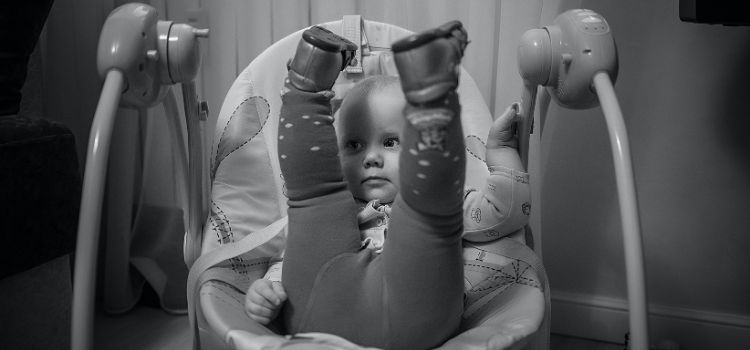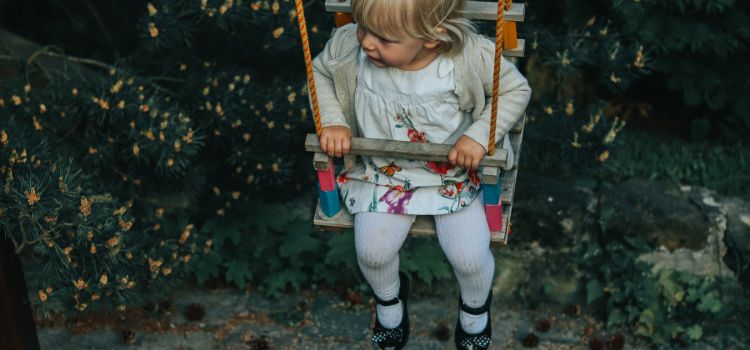As an Amazon Associate I earn from qualifying purchases.
A baby swing can completely transform your relationship with your infant and your life as a parent. It offers a calming and cozy atmosphere, providing you a much-needed respite and amusing your child at the same time. However, there comes a point where you must stop using it, just like with any baby product.

This blog post will go through the things to think about and warning flags to watch out for when deciding when to stop using baby swing. Let’s get started and ensure that we are giving our children the greatest care possible.
Importance of knowing when to stop using a baby swing
For your child’s safety and growth, it is crucial to know when to cease using a baby swing. For infants, baby swings offer a calming and comforting atmosphere, but it’s important to realize that there comes a moment when they shouldn’t be utilized.
Once your infant has reached the manufacturer’s recommended weight or age restriction, it is advised to discontinue using a baby swing. Overusing a baby swing may hinder the growth of their motor skills and reduce their opportunities for movement and exploration. Knowing when to stop using a baby swing will help you protect your child’s safety and encourage their development.
Safety concerns related to prolonged use of baby swings
Considerations for safety are crucial while using baby swings for an extended period of time. Parents frequently ask what the risks are and when to stop using baby swings. Although baby swings can be a practical and calming way to occupy infants, it is important to be aware of the suggested usage rules.

Long-term usage of baby swings can cause a number of safety problems, such as poor spine and neck alignment, muscular wasting, and a higher chance of falling. Therefore, knowing when to quit using baby swings is essential for preserving your child’s safety and well-being.
The purpose of this guideline is to help parents determine the appropriate time to stop using a baby swing
It’s crucial for parents to decide when to stop using a baby swing. With the help of this recommendation, parents will be better able to decide when it is time to wean their child from using a baby swing. For the child’s development and safety as they grow, it is crucial to understand when to cease using a baby swing. By heeding these suggestions, parents can decide when it’s appropriate to move on from the baby swing stage.
Age and Weight Guidelines: To Stop Using Baby Swing
Discuss the age and weight limits when to stop baby swing
Parental anxiety about when to stop using a baby swing is frequent. To protect your child’s safety, it’s critical to be aware of the manufacturer-recommended maximum ages and weights. Even while each baby swing may have unique requirements, it is generally recommended to stop using a baby swing once your child weighs between 25 and 30 pounds.
Furthermore, the majority of baby swings are created for babies up to a specific age, usually between 9 months and 1 year or when the child begins to sit up unsupported. Parents may make educated judgments about when to take their baby out of the swing and introduce them to other age-appropriate activities by keeping these age and weight restrictions in mind.
Explain the importance of following proper guidelines for the baby’s safety
Following the right instructions is crucial for the baby’s safety. When it comes to putting a baby swing to rest, it’s important to understand when to do so in order to protect your child’s health. Knowing when to stop using a baby swing helps you keep your child safe from accidents and injuries as they develop.
It’s important to follow the manufacturer’s suggested weight and age ranges. In addition, it’s crucial to keep a close eye on your baby’s growth and recognize when they’ve outgrown the swing. You may give your child a secure atmosphere where they can develop and thrive by adhering to the right rules.
Mention that every baby is different, so parents should consider their child’s individual development and size
It’s crucial to keep in mind that every infant is unique when selecting when to stop using a baby swing. To make an informed choice, parents should take into account the size and individual development of their child. While some infants may outgrow the need for a swing sooner than others, some may continue to feel supported and at ease in one for longer periods of time.
Parents can decide whether it’s appropriate to switch to other soothing and play techniques by paying attention to their baby’s indications and developmental milestones. Knowing when to cease using a baby swing depends on a parent’s awareness of their child’s safety and their understanding of the indicators of preparedness.
Signs of Outgrowing the Baby Swing:

Highlight physical signs, such as the baby’s legs dangling over the edge or being unable to fit comfortably
There are certain physical symptoms to watch out for when deciding when to quit using a baby swing. One of these indications that a child has outgrown a swing is when the child’s legs begin to dangle over the side.
Another red flag is if the infant can’t move around freely in the swing or feels claustrophobic. The baby’s safety and comfort can be increased by being aware of these physical warning signs.
Discuss behavioral signs, such as increased restlessness or a desire to explore outside of the swing
It’s crucial to pay attention to specific behavioral indicators when deciding when to cease using a baby swing. Increased restlessness or a strong urge to venture outside the swing may be among these warning indicators. It’s important to pay close attention to these actions since they can be a sign that your baby is ready to move from swinging to more active play. Parents who are making decisions about whether to cease using a baby swing should be aware of these behavioral indicators.
Developmental Milestones:
Explain how a baby’s developmental milestones can influence the need to stop using a baby swing.
When discontinuing using a baby swing can be significantly influenced by the developmental stages of the child. These developmental milestones, including as pulling up to stand, crawling, and sitting up alone, show that the infant is gaining strength, coordination, and balance. The requirement for a baby swing decreases as the infant grows more independent and mobile.
In order to promote their child’s continuous development, parents must be aware of these milestones and gradually introduce new types of play and exploration to their infant. It is important to know when to cease using a baby swing so that the child’s physical development is suitably challenged and fostered.
Discuss specific milestones such as sitting independently, crawling, or pulling up to a standing position.
There are various significant milestones to take into account when talking about a baby’s developmental timeline. These developmental stages include pulling oneself up to a standing position, crawling, and independent sitting. Each of these developmental milestones marks a critical turning point in a baby’s physical growth and can be thrilling for both parents and children.
Parents must understand when to quit using a baby swing, though. For the child’s safety and well-being, it is essential to know when to transfer away from a swing and at what age and developmental stage.
Transitioning to Other Forms of Entertainment and Mobility:
Discuss the importance of providing a variety of stimuli for a baby’s development.
To promote a baby’s development, it’s important to offer a diversity of stimuli. Many parents are unsure of the appropriate time to quit utilizing baby swings. While baby swings can soothe and calm babies, it’s crucial to realize that they shouldn’t be the only kind of stimulus for a baby’s growth. Infants thrive on a variety of sensory experiences, such as stimulation of the visual, aural, and tactile senses.
Parents can promote their baby’s cognitive, emotional, and physical development by exposing them to a variety of stimuli, such as vibrant toys, calming music, and gentle touch. Therefore, it’s crucial to understand when to stop using a baby swing to make sure that babies are exposed to a variety of stimuli for the best possible growth and exploration.
Provide ideas for alternative forms of entertainment, such as play mats or activity centers.
When it’s time to quit using a baby swing, playmats, and activity centers are fantastic options for keeping babies entertained. These adaptable and interactive solutions offer young children a fun and safe environment in which to play and explore. Babies can play with toys or engage with sensory objects while lying on a soft, cushioned surface provided by playmats.
On the other hand, activity centers offer a variety of amenities like spinning toys, mirrors, and music, which can occupy and stimulate babies. Playmats and activity centers can be a fun and engaging part of your baby’s routine that will encourage their growth and keep them occupied for a long time.
Discuss the transition from swing-based entertainment to more interactive play.

In the field of infant toys, there has been a considerable movement from swing-based entertainment to more participatory play. Parents are now choosing toys and activities that encourage engagement and growth more frequently.
The realization that babies gain a lot from interactive play, which helps develop their cognitive, social, and motor skills, is what inspired this development. Because of this, parents who want to provide their children with more involved and stimulating experiences frequently wonder when to quit using a baby swing.
Conclusion
In conclusion, it’s critical to understand when to cease using a baby swing for your child’s safety and growth. It is vital to introduce children to new types of play and stimulation as they get older and more mobile in order to promote their physical and intellectual growth.
You can make sure that your child’s time in a baby swing is both pleasurable and safe by carefully checking their weight and age restrictions, keeping an eye on their level of comfort and involvement, and adhering to the manufacturer’s standards. Every child is unique, so it’s important to consider their specific needs and make the necessary modifications as they continue to develop and grow.
Amazon and the Amazon logo are trademarks of Amazon.com, Inc, or its affiliates.